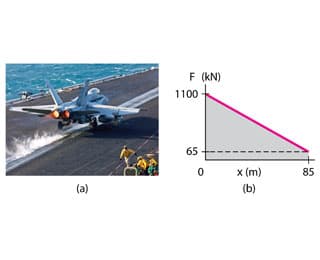A 17,000-kg jet takes off from an aircraft carrier via a catapult (Figure 1). The gases thrust out from the jet's engines exert a constant force of 135 kN on the jet; the force exerted on the jet by the catapult is plotted in the figure. a.) Determine the work done on the jet by the gases expelled by its engines during launch of the jet. Express your answer to two significant figures and include the appropriate units. b.)Determine the work done on the jet by the catapult during launch of the jet. Express your answer to two significant figures and include the appropriate unit
A 17,000-kg jet takes off from an aircraft carrier via a catapult (Figure 1). The gases thrust out from the jet's engines exert a constant force of 135 kN on the jet; the force exerted on the jet by the catapult is plotted in the figure. a.) Determine the work done on the jet by the gases expelled by its engines during launch of the jet. Express your answer to two significant figures and include the appropriate units. b.)Determine the work done on the jet by the catapult during launch of the jet. Express your answer to two significant figures and include the appropriate unit
Physics for Scientists and Engineers: Foundations and Connections
1st Edition
ISBN:9781133939146
Author:Katz, Debora M.
Publisher:Katz, Debora M.
Chapter7: Gravity
Section: Chapter Questions
Problem 10PQ
Related questions
Topic Video
Question
A 17,000-kg jet takes off from an aircraft carrier via a catapult (Figure 1). The gases thrust out from the jet's engines exert a constant force of 135 kN on the jet; the force exerted on the jet by the catapult is plotted in the figure.
a.) Determine the work done on the jet by the gases expelled by its engines during launch of the jet.
Express your answer to two significant figures and include the appropriate units.
b.)Determine the work done on the jet by the catapult during launch of the jet.
Express your answer to two significant figures and include the appropriate units.

Transcribed Image Text:F (kN)
1100 -
65
x (m)
85
(a)
(b)
Expert Solution
Step 1
Given:
Mass of the jet M = 17000 kg.
Force exerted by gases to jet plane
Trending now
This is a popular solution!
Step by step
Solved in 3 steps

Knowledge Booster
Learn more about
Need a deep-dive on the concept behind this application? Look no further. Learn more about this topic, physics and related others by exploring similar questions and additional content below.Recommended textbooks for you

Physics for Scientists and Engineers: Foundations…
Physics
ISBN:
9781133939146
Author:
Katz, Debora M.
Publisher:
Cengage Learning

Physics for Scientists and Engineers: Foundations…
Physics
ISBN:
9781133939146
Author:
Katz, Debora M.
Publisher:
Cengage Learning